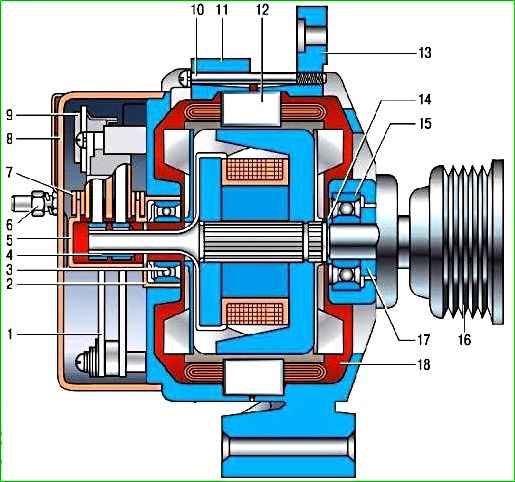Generator type 9402.3701-01 alternating current, three-phase, with built-in rectifier unit and electronic voltage regulator, right-hand rotation (drive side)
The generator installed on the car used for photography has a V-belt drive.
The repair work is shown using the example of a generator with a multi-groove pulley.
All elements of both generators, except for the pulleys, are absolutely identical.

The generator anchor is driven from the crankshaft pulley by a V-belt or (depending on the version) a poly-V-belt.
The stator 12 (Fig. 1) and covers 11 and 13 are tightened with four screws.
The rotor shaft 18 rotates in bearings 3 and 15, which are installed in the covers.
Power is supplied to the rotor winding (excitation winding) through brushes and slip rings 4.
The three-phase alternating current induced in the stator winding is converted into direct current by the rectifier unit 1, attached to the cover 11.
The electronic voltage regulator 9 is combined into one unit with the brush holder and is also attached to the cover 11.

The generator connection diagram is shown in Fig. 2.
The voltage for exciting the generator when the ignition is turned on is supplied to the terminal "D+" of the regulator (terminal "D" of the generator) through the control lamp 3, located in the instrument cluster.
After starting the engine, the excitation winding is powered by three additional diodes installed on the rectifier block of the generator.
The terminal "W" of the generator is not used on VAZ-2123 family cars.
The operation of the generator is monitored by the control lamp in the instrument cluster.
When the ignition is turned on, the lamp should light, and after the engine starts, it should go out if the generator is in good condition.
A bright or dim lamp indicates a malfunction.
Technical characteristics of the generator
Maximum output current (at 13 V and 6000 min -1), A - 80
Adjustable voltage limits, V - 13.2-14.7
Engine-generator gear ratio 1:2.16
If the generator belt breaks on the road and you forgot the spare at home, it can be temporarily replaced with a 20 mm wide ring cut from an old car inner tube.
To reduce current consumption when driving a car with a faulty generator, if possible, turn off the radio, unnecessary lighting devices, heater fan, glass heating, etc.





